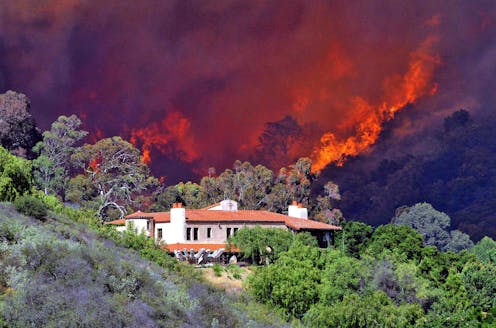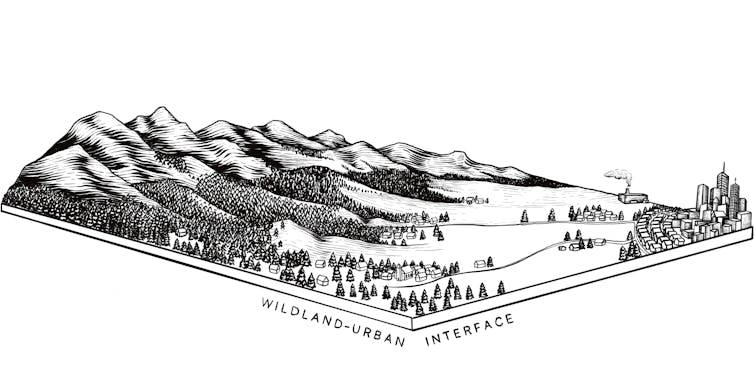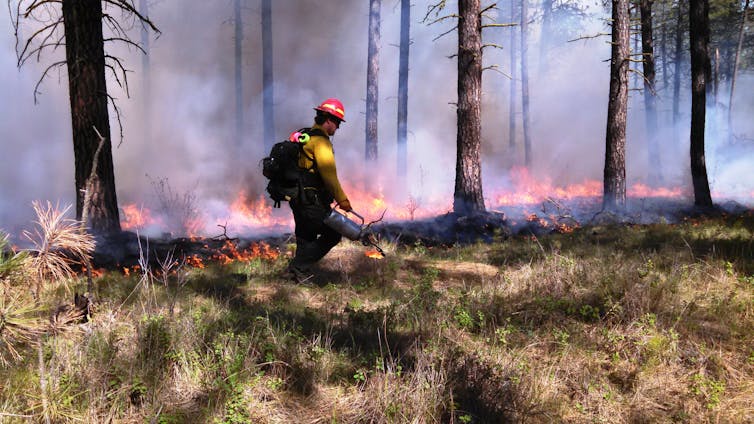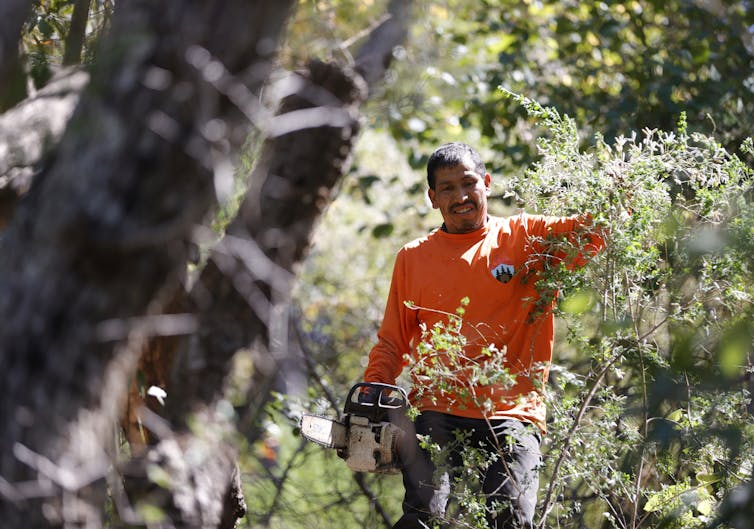
Humans have learned to fear wildfire. It can destroy communities, torch pristine forests and choke even faraway cities with toxic smoke.
Wildfire is scary for good reason, and over a century of fire suppression efforts has conditioned people to expect wildland firefighters to snuff it out. But as journalist Nick Mott and I explore our new book, “This Is Wildfire: How to Protect Your Home, Yourself, and Your Community in the Age of Heat,” and in our podcast “Fireline,” this expectation and the approach to wildfire will have to change.
Over time, extensive fire suppression has set the stage for the increasingly destructive wildfires we see today.
The problem with fighting every fire
The way the U.S. deals with wildfires today dates back to around 1910, when the Great Burn torched some 3 million acres across Washington, Idaho, Montana and British Columbia. After watching the fire’s swift and unstoppable spread, the fledgling Forest Service developed a military-style apparatus built to eradicate wildfire.
The U.S. got really good at putting out fires. So good that citizens grew to accept fire suppression as something the government simply does.

Today, state, federal and private firefighters deploy across the country when fires break out, along with tankers, bulldozers, helicopters and planes. The Forest Service touts a record of snuffing out 98% of wildfires before they reach 100 acres (40 hectares).
As a result, many forest ecosystems that would have periodically burned have become clogged with underbrush, new growth and woody debris that can easily ignite. Efforts by the Forest Service to adopt a more selective policy have run into opposition from Western politicians.
At the same time, people have built more homes and cities in fire-prone areas. And the greenhouse gases released by decades of increasingly burning fossil fuels have caused global temperatures to rise.

Climate change and wildfires
The relationship between climate and wildfire is fairly simple: Higher temperatures lead to more fire. Higher temperatures increase moisture evaporation, drying out plants and soil and making them more likely to burn. When hot, dry winds are blowing, a spark in an already dry area can quickly blow up into dangerous wildfire.
Given the rise in global temperatures that the world has already experienced, much of the Western U.S. is actually in a fire deficit because of the practice of suppressing most fires. That means that, based on historical data, we should expect far more fire than we’re actually seeing.
Fortunately, there are things everyone can do to break this cycle.
What fire managers can do
First, everyone can accept that firefighters can’t and shouldn’t put out every low-risk wildfire.
Remote fires that pose little threat to communities and property can breathe life into ecosystems. Low-level fires that clear out undergrowth but don’t kill the trees create space for trees, plants and wildlife species to thrive, and they return nutrients to the soil. Some tree and plant species depend on fires to open their seeds to reproduce.
Natural fires can also help avoid catastrophic fires that occur when too much underbrush has built up for fuel. And they create fuel breaks on the landscape that could halt the advance of future flames.

Fire managers have advanced mapping technology that can help them decide when and where forests can burn safely. Thoughtful prescribed burning – meaning low-intensity fires intentionally set by professionals – can offer many of the same benefits as the flames that historically burned in forests and grasslands.
The Forest Service is aiming to ramp up its prescribed burning on more acres in more areas across the country. However, the agency struggles to train adequate staff and pay for the projects, and environmental reviews sometimes cause yearslong delays. Other groups offer beacons of hope. Indigenous groups across the country, for example, are returning fire to the landscape.
Adapting homes to fire risk
For decades, scientists have understood the relationship between wildfire and community destruction. However, little has been done to live safely with fire on the ground. More than one-third of U.S. homes are in what’s known as the wildland-urban interface – the zone where houses and other structures intermingle with flammable vegetation.
The biggest risk to homes comes from burning embers blowing on the wind and landing in weak spots that can set a house ablaze. Those embers can travel over a miles to nestle in dry leaves or pine needles clogging a gutter, a wood-shingle roof or shrubs, trees and other flammable vegetation close to a structure.

Some of these vulnerabilities are easy to fix. Cleaning a home’s gutters or trimming back too-close vegetation requires little effort and tools already around the house.
Grant programs exist to help harden homes against wildfire. But enormous investment is needed to get the work done at the scale the fire risk requires. For example, nearly 1 million U.S. homes in wildfire-prone areas have highly combustible wooden roofs. Retrofitting those roofs will cost an estimated US$6 billion, but that investment could both saves lives and property and reduce wildfire management costs in the future.
Homeowners can look to resources like Firewise USA to learn about the “home ignition zone.” It describes the types of vegetation and other flammable objects that become high risks at different distances from a structure and steps to make properties more fire resilient.
For example, homes should not have flammable plants, firewood, dried leaves or needles, or anything burnable, on or under decks and porches within 5 feet (1.5 meters) of the house. Between 5 and 30 feet (9 meters), grasses should be mowed short, tree branches should be pruned to at least 6 feet (2 meters) from the ground, and the tree canopy should be at least 10 feet (3 meters) from the structure.
What communities can do
Many counties and cities have their own wildfire programs to educate homeowners and connect them with resources. Some have started “tool libraries” to help anyone begin the necessary work on their property.
Beyond individual actions, states and communities can enact forward-looking wildfire resilience policies.
These can include developing zoning rules and regulations that require developers to build with fire-resistant materials and designs or might even prohibit building in areas where the risk is too high. The International Wildland-Urban Interface Code, which provides guidance for safeguarding homes and communities from wildfire, has been adopted in jurisdictions in at least 24 states.

Living in a world with wildfire
Prevention and suppression will always be critical pieces of wildfire strategy, but adapting to our fiery future means everyone has a role.
Educate yourself on proposed forest projects in your area. Understand and address risks to your home and community. Help your neighbors. Advocate for better wildfire planning, policy and resources.
Living in a world where more wildfire is inevitable requires that everyone see themselves as part of solving the problem. Wildfire can be terrifying, but also natural and essential. Embracing both isn’t always easy, but I believe it is the only way forward.
Justin Angle is under contract with Bloomsbury to publish the forthcoming "This is Wildfire: How to Protect Your Home, Yourself and Your Community in the Age of Heat."
This article was originally published on The Conversation. Read the original article.







